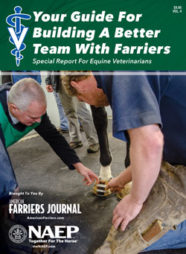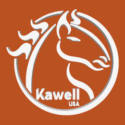You may struggle to find clients when you are starting out. Your area may lack the number of potential clients to sustain your practice. Perhaps you lack the skill, experience and confidence to work with clients on your own. Whatever the reason, you may consider working as an apprentice when you launch your career.
Many novice farriers will work in an apprenticeship while they serve clients on their own. This solution allows them to improve their knowledge and gain experience under a mentor while developing a sustainable practice.
This was the case for Kelley House, a shoer from Colgate, Wis. Seven years ago, the journeyman tool and die maker found himself out of work. Seeing the opportunities of similar manufacturing jobs disappearing the United States, House decided to change careers and become a horseshoer.
Today, he shoes 3 days on his own and apprentices 2 days each week in Hall Of Fame shoer Red Renchin’s multi-farrier practice.
House’s experiences on 2 days give a glimpse at the difference between what you can expect when you shoe alone vs. when you work as an apprentice.
Part of a Team
“We’re going to need some 0’s,” Kelley House calls out to Nick Martin. Both work as apprentices in Red Renchin’s multi-farrier practice based in Mequon, Wis. As Renchin goes over his notes for the day, House and Martin dig through shoes, performing the daily ritual of properly stocking the shoeing rig’s inventory.
“You don’t want to run out of shoes when you are riding with Red,” comments House.
He is quite familiar with his mentor’s practices, having worked for Renchin after graduating from the 12-week program at the Midwest Horseshoeing School in Macomb, Ill., in 2003.

When you work as an apprentice, perform any duty your mentor requests, like loading the truck before beginning the day.
With truck loaded, the crew hits the road, headed to Summit Farms in Oconomowoc, Wis. The hunter/jumper barn is a typical stop for Renchin, as the performance horses make up the majority of his books. He serves several other barns in the area, as well as an equine hospital nearby.
After the 45-minute drive, the Ford F-250 arrives at Summit Farms. In a reversal of the earlier events of the day, House and Martin unload the truck. When the stations and three sets of cross-ties are in place, the barn aisle takes more of the appearance of an assembly line, with Renchin acting as foreman.
Houses’s primary duties when shoeing will be to finish the feet after Renchin nails on the shoes. He rarely deviates from the factory-like progression of the barn, other than to safe shoes, push a broom or help with the occasional antsy horse.
In this seasoned practice, there are few surprises. Or to be more accurate, fewer surprises compared to that of a fledgling practice. The thoroughness of Renchin’s planning ahead helps with this prevention. The biggest surprise of the day was an unexpected stallion among the group at Summit Farms
This discipline and structure appeal to House. While some farriers may have left before putting in the years that House has with Renchin, he sees a greater benefit from the opportunity to learn from a top shoer. Not to mention, the rare combination of good pay and benefits. Several shoers in the area have gone through Renchin’s program.
Looking back at what has made successful apprentices, Renchin says one of the most important qualities is a pleasant personality.
“You need to be someone I can get along with,” says Renchin. “Like I told my wife, I see my employees more than I see her.”
Renchin also looks for apprentices who has a mechanical mind or is good with their hands. Having an additional skill like welding can make you more useful as an apprentice.
It is just past 1 p.m. and the crew has tackled seven horses. With the Ford packed up, they’ll eat lunch as the truck heads back the way they came for a second barn. It is a quick visit, with only one horse.
After a wet June, the horses’ hooves are drying out and have lost some strength. In the shoeing process, House helps Renchin apply Equilox to replace part of the hoof wall that has disappeared. House will finish the feet after Renchin has nailed the shoes on.
There is one more horse today at a riding and boarding barn near Renchin’s home. The visit is a nice way to end the day: resets on the well-behaved horse.
You could accurately describe the day as formulaic. Renchin would take that as a compliment, as it means the day went as planned.
And for House it means another day of improving his hoof-care knowledge while earning good pay. Tomorrow he will ride alone in his own practice, serving his own clients in what will be a different experience.
His Own Boss
Kelley House is not bashful when he discusses the model for his business. “I emulate a lot of the things that Red does — why wouldn’t I? Riding with Red is like a daily clinic,” he says. From keeping notes on the horses to shoeing philosophy, House credits his mentor with influencing the way he runs his day-to-day operations.
However the practice isn’t an exact mirror image. On the way to the first stop, a private barn in Richfield, Wis., House explains that it has been a struggle to find enough clients to fill his books. Before his apprenticeship, he visited nearly any place with a barn around his home, looking for clients. Today, the main source of clients proves to be those that Renchin turns away, as his books are closed.
The pony is hesitant about its right hind being worked on and fights House. Even with the animal’s best effort, he finishes the trim and shoeing job on the pony. After he bills the client, House says it takes a lot more than this horse’s reaction to make him turn away a client or charge a fee for the extra effort required.

Wisconsin shoer Kelley House traded the tool and die trade for horseshoeing. He spends part of his week shoeing on his own, and the other in a multi-farrier practice.
With the first stop out of the way, the day looks promising. The next stop will be in House’s hometown of Colgate at Blue Springs Farm, a riding and boarding center. According to his schedule, there will be eight trims, primarily with broodmares.
However, the barn manager has thrown a monkey wrench in those plans and brought out a gelding that needs new shoes. The horse and a few other recent acquisitions have landed on House’s lap. Although it changes the structure of the day, these new horses won’t draw any complaints from him.
“This barn is only a few miles form my home, so I can work them into my schedule,” he says. “I need to see another horse later today, but have to be accommodating to this barn too.”
House has trimmed the fronts and hinds, the horse will only require shoes on the front. As he examines the front right, he sees the evidence of a laminitic past.
“I want to stay on top of this issue,” says House. “It is my responsibility to see this horse regularly. It won’t ever be normal-normal, but we’ll get it a lot closer.”
House keeps his clients on a 6-week schedule, especially in situations like this where he is seeing a new horse with problem feet.
He’s moved on to another new horse. House finishes the front left before he cleans the front right.
“She’s a pawer. This is one of those times it would be good to have another shoer in the barn,” he says with a laugh.
The clock is just past noon when House looks at his watch. He realizes that there isn’t enough time to tackle all of the horses he was supposed to trim, so he will finish with the new ones and come back whenever he has extra time over the next few days. He lets the manager know, who is agreeable because she knows House’s proximity to the barn.
“Like the Boy Scouts’ motto, ‘Be prepared,’” says House.
He’ll work on a new horse before moving along to the next stop, fittingly Summit Farm.
There he works with a dressage gelding that House refers to as “a work in progress.”
As he finishes the front left of the conformationally-challenged horse, House reflects on what it took to grow his practice. He believes having a career in a trade before farriery helped him understand what is required to succeed.
“You have to take your time and learn as much as you can,” he says. “Don’t think you can pick it up overnight.”
What Is Expected Of An Apprentice?
Three operators (Mike DeLeonardo of Salinas, Calif.; C. Kent Misener of Rosebud, Mo.; and Jeff Pauley of Burnsville, N.C.) share their insight on what it takes to be a farrier apprentice.
What They Look For
Pauley wants an apprentice who comes to the table with an open mind and is in good physical health. “You also need some ability to shoe a horse, to safely prep a foot,” he says “If you come out of shoeing school without that understanding, you’ll be lost.”
DeLeonardo wants someone with knowledge of anatomy and who has skills in the forge. To work for him, you must be able to be able to hand make a front and hind pattern to a specimen.
Getting Ahead
According to Misener, a novice shoer to succeed as an apprentice, he or she must be dedicated and work hard. Try to keep pace with your mentor, but don’t try to impress by being fast. What you will do must be approved by your mentor. “I have to know what you are doing is what my customer is expecting,” he says.
DeLeonardo finds that the apprentices who succeed are the ones who put in the time when they aren’t riding with him. Away from work, they will go to hoof-care clinics and seminars.
Pauley says you need to put in the time. He finds the most successful shoers are the ones who have apprenticed for longer periods of time.
Falling Out Of Favor
If you want to quickly wear out your welcome in an apprenticeship, your quickest route is through your actions and disposition.
DeLeonardo says you will be fired if you show up late for work and have a bad attitude around clients and horses. Also, if you disrespect your mentor and fail to practice the craft, you’ll need to find a new apprenticeship.
Misener says if your attitude is to expect much from only a little investment in your work, you won’t succeed as a shoer.
“I know of an older shoer who worked 7 years for a room and meals and the chance to learn the trade,” recalls Misener. “In this trade, the only way to gain a lot is to do a lot. If you are just looking for money you’ll find it, but I would encourage you to look higher. You can do better than just that. I love this trade, and other than God and family, it is my pride and passion.”






